|
|
 "QUANTUM SHOT" #610 "QUANTUM SHOT" #610
Link - article by Simon Rose and Avi Abrams
Graphical Marvels, Forged Notes, Hyperinflation "Riches" and Propaganda Bed Sheets
"Paper money eventually returns to its intrinsic value - zero." (Voltaire, 1694-1778)
World's historical bank notes often provide the clearest and unique view on country's political and design sensibilities. For example, old Russian Empire bank notes were pretty elaborate and some of the largest in size:
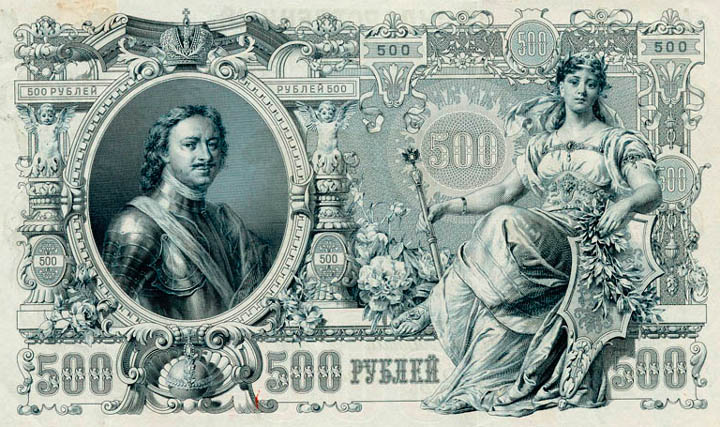
(1912 Russian empire banknote with Czar Peter the Great)
German crisis money around 1921 "Serienscheine" (series notes) are especially fascinating from a graphical viewpoint - see more here:
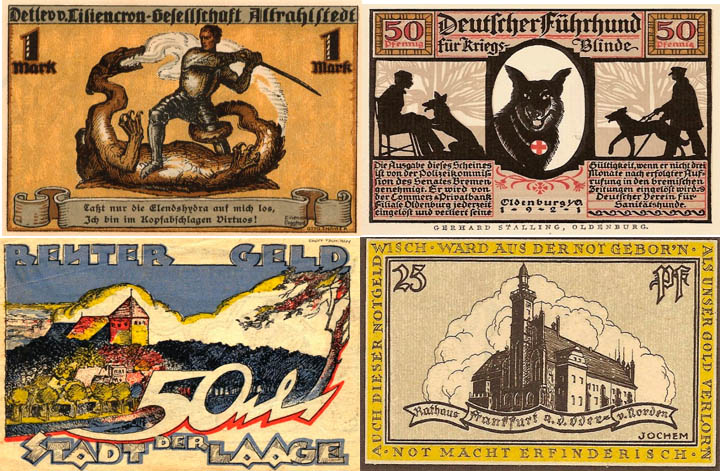
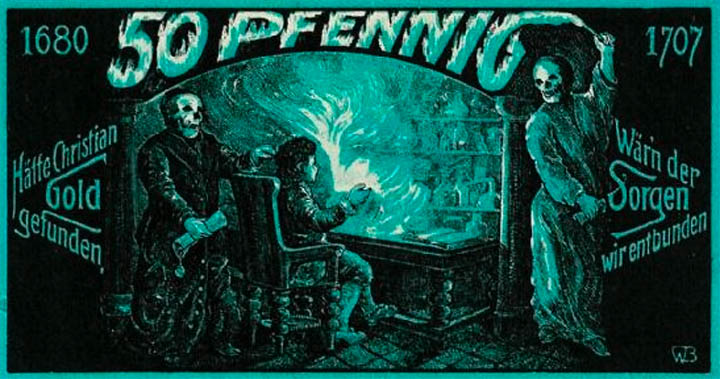
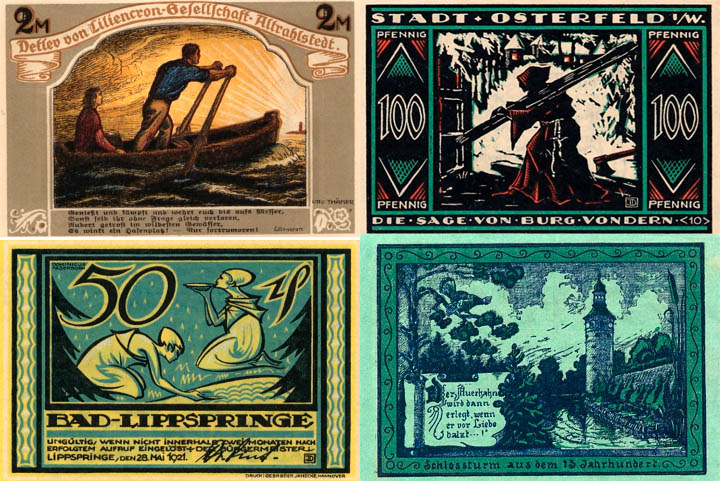
(images via)
Imaginary (thank God!) Bank of Cthulhu:
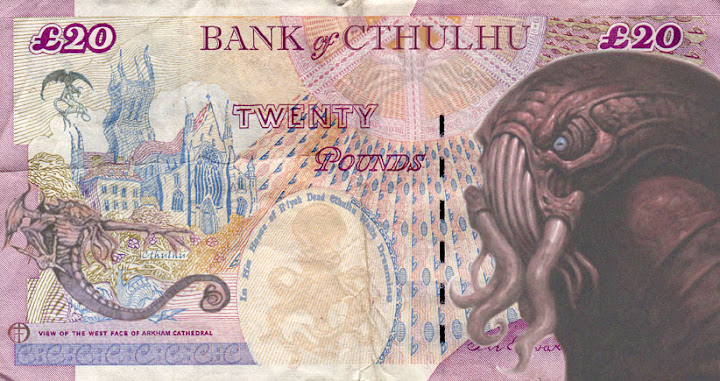
(image via)
Polish bank notes with Frédéric Chopin - an epitomy of culture:

(image via)
A humble squirrel is featured on bank notes from Belarus:
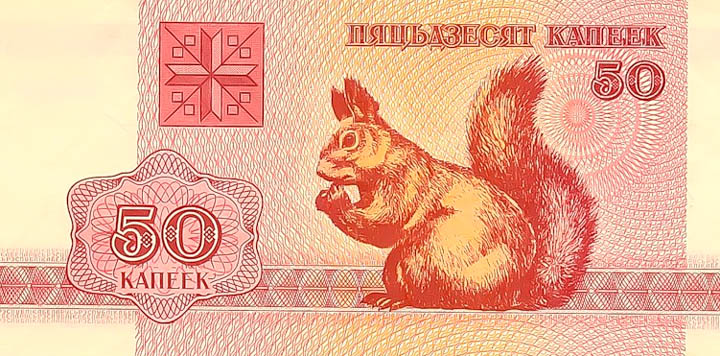
The world’s oldest known banknote
The earliest recorded use of paper money is in China around 800 AD, although the Chinese abandoned paper money in the mid fifteenth century. This Chinese Kuan note is the world’s oldest known banknote, from around 1380.
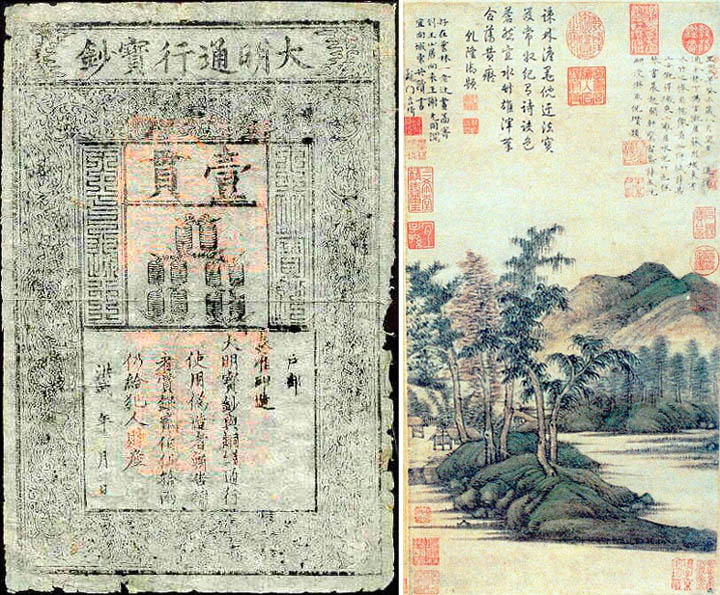
(left: the Kuan note; right: painting from this period, by Ni Zan - images via 1, 2)
European paper money as we would recognize it today seems to have its origins in the seventeenth century. In 1633, English goldsmith certificates were being used as receipts for customers to reclaim deposits, and also as evidence of someone’s ability to pay. By 1660, these receipts were recognized as a convenient alternative to handling coins or bullion, a forerunner perhaps of the banknote in England.
The Bank of Sweden was founded in 1656, granting loans and mortgages, issuing bills of credit and taking deposits. In 1661, it was the first chartered bank in Europe to issues notes. This hundred Daler note was issued in 1666:

(image via)
In the UK, the Bank of England has been issuing banknotes since 1694, but didn’t have a legal monopoly until 1921. Decimal currency was introduced in the UK on February 15, 1971. The fifty pence coin, one of the first new ones issued, is very familiar to the people of Britain since its introduction almost four decades ago, but still seems odd to the outsider with its heptagonal shape (below, left).

(images via 1, 2)
The British public, however, had seen a multi-sided coin before. The threepenny bit was introduced in the mid-thirties, although a threepenny coin had been minted in silver since 1547. The twelve-sided version would remain in circulation until 1970 (above, middle). However, the new decimal system wasn’t without its oddities. The half penny coin enjoyed a surprisingly long and increasingly pointless existence, before it was withdrawn from the monetary system in 1984 (above, right).
Scotland has a number of distinct institutions, quite separate to England and Wales, and this includes currency. Scottish banknotes are recognized as currency in Scotland and usually in other parts of the UK, but may be refused by people in stores who are unfamiliar with such notes. However, they are of the same value as English notes and financial institutions will accept them without question:

Banknotes issued by Northern Ireland banks have similar status to Scottish ones and can technically be used anywhere in the UK. However, they are rarely seen outside Northern Ireland and are thus equally rarely accepted in England and Wales, although once again, financial institutions will readily take them. This limited edition banknote from 2006 commemorates the soccer legend George Best:
 o o
The Channel Islands and the Isle of Man are somewhat confusingly possessions of the British Crown, but not part of the UK. Consequently, although they have currency unions with London, they each issue their own banknotes. However, unlike Scotland and Northern Ireland, these notes cannot be used in the UK.
This Isle of Man banknote displays the island’s famous three-legged symbol:
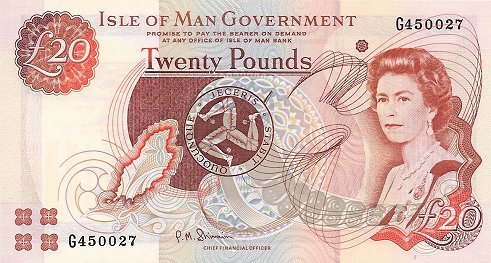
These examples are from the islands of Jersey and Guernsey, located off the northern coast of France:

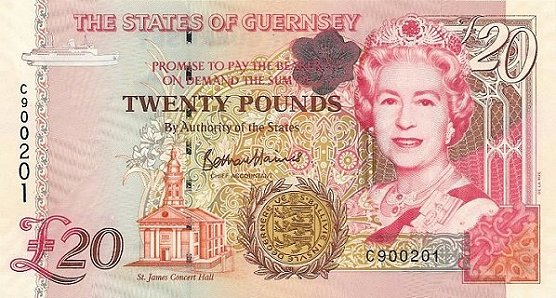
(images via)
The Channel Islands were the only British territory to be occupied by Germany during World War Two. These are pictures of currency used during the German Occupation. The top ones were used by the people of Guernsey, while the lower one shows the military currency used by German army:

Also from World War Two, here is this great example of forged currency. Operation Bernhard was the German plan to destabilize the British economy by printing phoney banknotes in various denominations. In 1943, 500,000 notes were produced, which were planned to be parachuted over Britain. The Allies retrieved most the notes at the end of the war, but forgeries still occasionally appeared for several years after 1945:
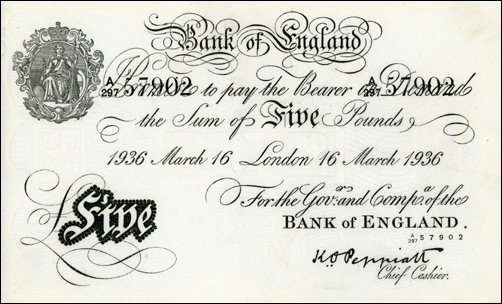
Remnants of a once mighty empire, there are fourteen British Overseas Territories which all issue their own currencies, including Gibraltar, Saint Helena and the Falkland Islands, none of which are legal in the UK or outside the territories of origin (below, left):
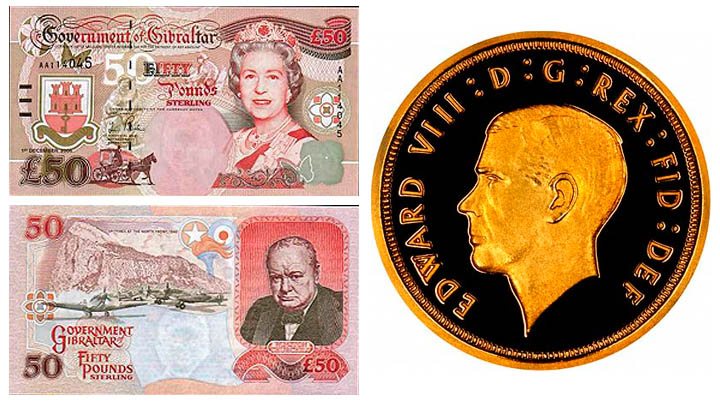
(images via)
In 1936, King Edward VIII abdicated the throne of England and was never actually crowned. As a result, coins bearing his head are collectors items. In the 1930’s, the British Empire spanned the globe and here’s a sovereign minted for the new king in Canada (above, right)
Also from North America, no article on currency would be complete without some mention of banknotes issues by the Confederate States of America during the Civil War. Here are two examples of Confederate twenty dollar bills from 1861 and 1864:
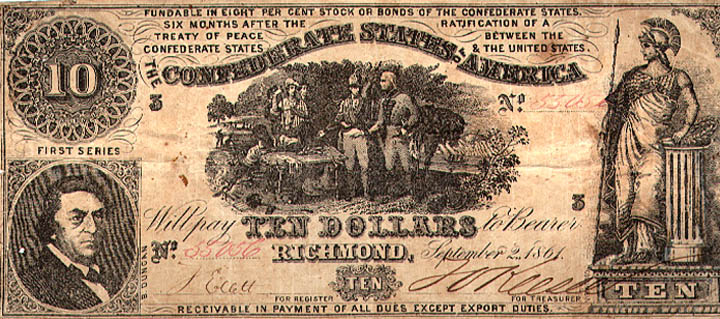

(images via)
There was of course another independent country in the southern part of what is now the United States a few decades earlier. Here’s some money issued by the Republic of Texas in the 1830’s:

(image via)
Although the shape of the British three penny and fifty pence coins may seem somewhat odd to non-UK residents, how about these coins minted in Zambia in honour of the 2000 Sydney Olympics? -
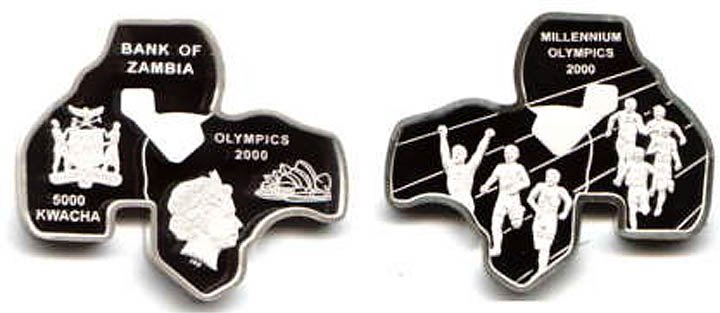
(image via)
Also in Africa, the economic troubles of Zimbabwe in recent years have been reflected in the currency, such as this ten million dollar banknote from 2008:

However, it has been exceed by far with this one (click to enlarge):
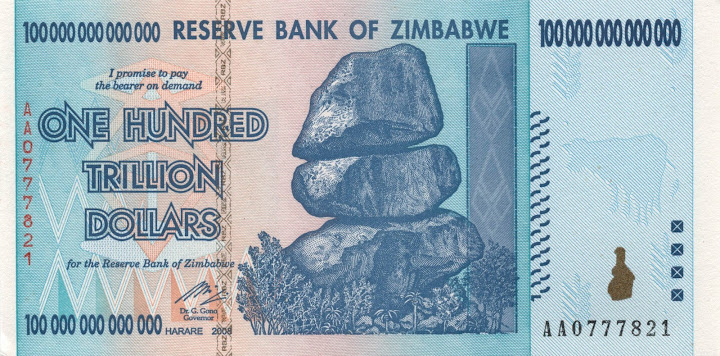
(image via)
Zimbabwe is not the first country to experience such hyperinflation, of course. After the First World War, Germany endured a severe economic crisis. In 1914, the highest denomination German note was for 1000 Mark, which was worth approximately 238 US dollars or 50 British pounds. In early 1922, the government issued 10,000 Mark notes, but by February 1923, Germans were using banknotes in denominations of 100,000 and 1 million Marks. Notes reached 50 million in July, 10 billion in September and 100 trillion when hyperinflation peaked in October 1923.
Just to give you an idea of what this meant for the average German, on November 1 1923, you could buy a loaf of bread for a measly three billion or truly splash out and get three pounds of meat for 100 billion. By November 15, 100 billion would get you two glasses of beer, not really enough to make you forget your troubles, while that loaf would now cost you 80 billion.
When it was all over, these huge banknotes were worth around 5 pounds or 24 US dollars. On November 15, the government introduced a new currency, one unit of which was worth a trillion of the old Marks. Prices eventually stabilized, but most of the population had nevertheless seen their wealth vanish.
5 Million Mark Note issued in Dresden on August 21, 1923:

Ten million:
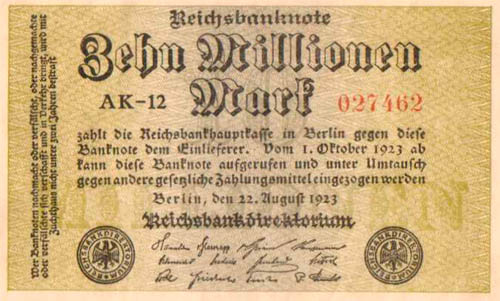
50 million:
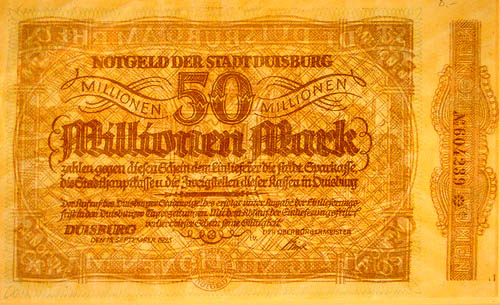
100 million:

500 million:

100 trillion, Nov. 3 1923 - see this site for more:
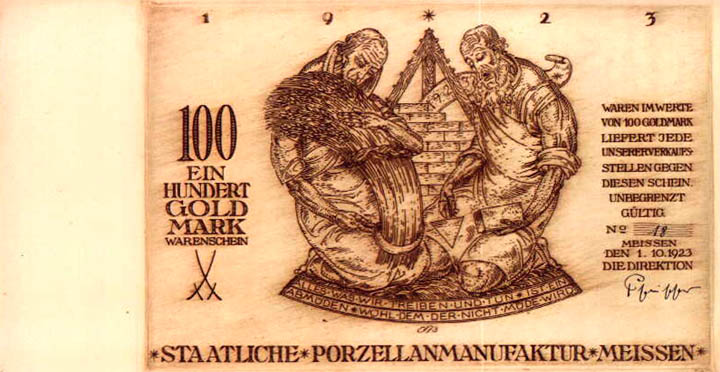
(image via 1, 2, 3, 4)
Later in the interwar period Germany got a new government who’s head actually resisted having his own head on the national currency. However, with victory seemingly within sight, Adolf Hitler decided that his head should indeed adorn the country’s money, after the anticipated final triumph. This design for a five reichsmark coin was struck in 1942, but never issued:
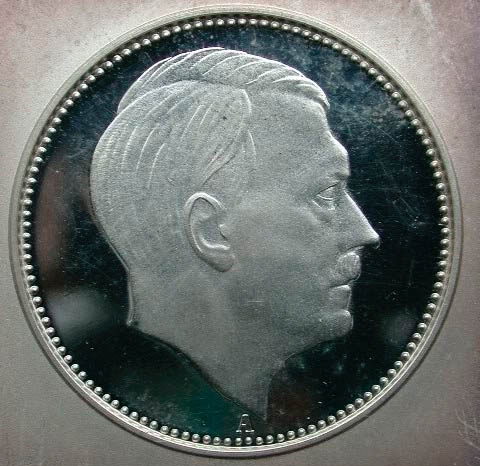
The following banknotes were created by the Nazis for the infamous concentration camp, at Theresienstadt in what is now the Czech republic. The camp served as a showpiece for the Nazis to demonstrate to the Red Cross and other agencies how Jewish prisoners were being well treated, took part in cultural events and had schools for their children. In reality, over 30,000 people died in Theresienstadt and almost 90,000 were sent from there to extermination camps further east. These 10 and 20 Kronen notes were part of the propaganda ploy presented to the Red Cross, but were simply papers with no value and never used:

Hitler’s fellow dictator, Josef Stalin, got his head on the 100 Kronen coin in Soviet occupied Czechoslovakia 1949:

In Asia, World War Two resulted in what turned out to be temporary occupation currency in a number of different countries. This ten military yen note 1941 was issued during the Japanese occupation of Hong Kong:
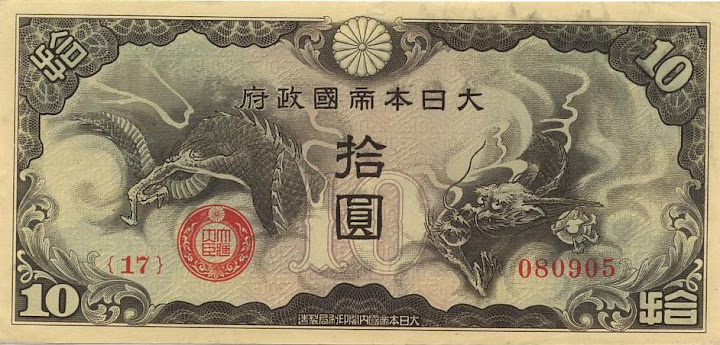

(image via)
This one is from the Philippines occupation:
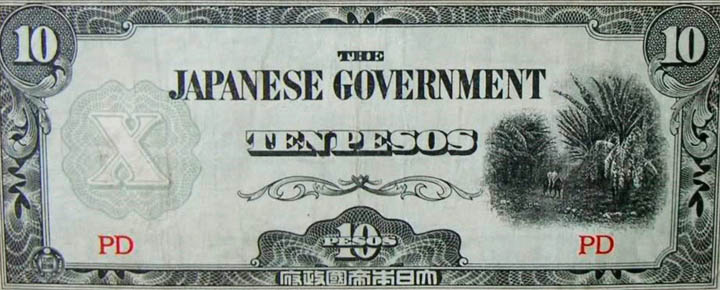
This 1944 100 Yuan banknote circulated in the Japanese puppet state of Manchukuo, better known as Manchuria, in north west China:
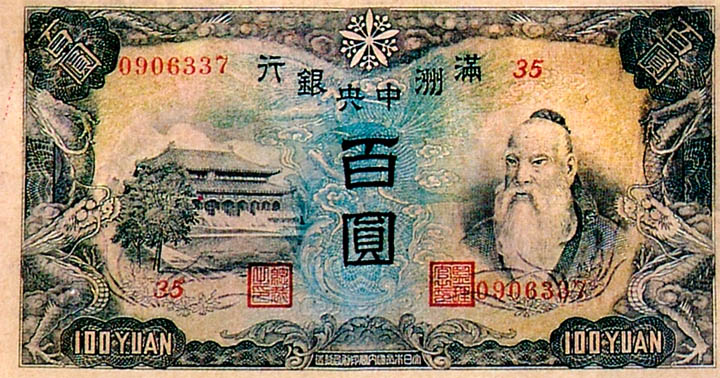
And finally, also from Asia, probably the largest banknote in the world - 16cm(6.3in) by 16cm(6.3in) - issued in Thailand in 1987:
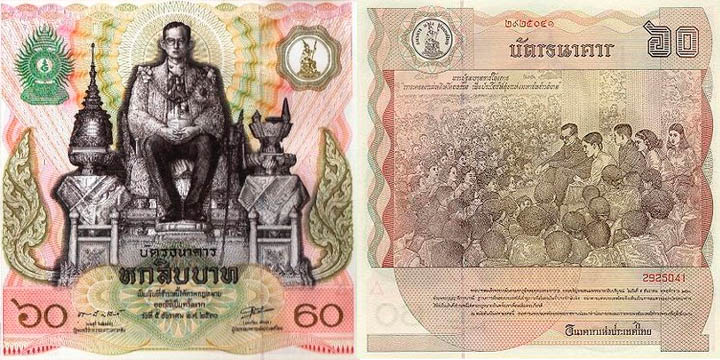
Bank note origami from a Japanese artist Hasegawa Yosuke - see his site for more:

(image credit: Hasegawa Yosuke)
For richer, or for poorer... collecting money is what most people do, or strive to do, anyway:

Article by Simon Rose and Avi Abrams, Dark Roasted Blend.
CONTINUE TO PART TWO! ->
ALSO READ "WORLD'S MOST CURIOUS EPHEMERA" ->
|
|
RECENT ARTICLES:
"Dark Roasted Blend" - All Kinds of Weird and Wonderful Things, Discovered Daily!"
DRB is a top-ranked and respected source for the best in art, travel and fascinating technology, with a highly eclectic presentation. Our in-depth articles in many categories make DRB a valued online magazine, bringing you quality info and entertainment every time you visit the site - About DRB
Connect with us and become part of DRB on Facebook and Twitter.
YOUR COMMENTS::
READ OTHER RECENT ARTICLES:
CATEGORIES:
Feel-Good! | airplanes | animals | architecture | art | auto | boats | books | cool ads | famous | futurism | food
gadgets | health | japan | internet | link latte | military | music | nature | photo | russia | steampunk
sci-fi & fantasy | signs | space | technology | trains | travel | vintage | weird | abandoned
|
|










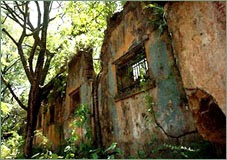






















































































24 Comments:
I love currency. Especially this:
http://www.facebook.com/group.php?v=wall&gid=6850966739
loving your work, your posts never fail to entertain.
the "100 million" Reichsmark note actually is worth 100 BILLION.
Another good post :) Surprised not to see any shinplasters though http://en.wikipedia.org/wiki/Shinplaster
You should mention the world recorder Hyperinflation "Riches", the Hungarian 100 million billion (100 quintillion) Pengo. Yes, that's a 1 with 20 zeros after it.
http://upload.wikimedia.org/wikipedia/commons/3/33/HUP_100MB_1946_obverse.jpg
http://en.wikipedia.org/wiki/Peng%C5%91
To DarkRoastedBlend.
Check that :
http://www.adme.ru/sberbank/kalendar-sberbanka-sdelali-iz-elementov-banknot-fastway-103341/
russian bank has released creative and weird 2010 calendar made of elements of money...
I second Carl. A milliarden is one billion, millionen is one million.
Well done; many thanks.
Typo: Edward VII should read Edward VIII.
Edward VIII became King instantly and absolutely upon the death of George V. After the death of a monarch, a period of respect for the dead monarch of approximately one year passes before the celebratory coronation ceremony (or "crowning") of the successor. Edward VIII abdicated before the end of the period of respect had passed, and thus he had not been "crowned" at the time of his abdication. Edward VIII was actually King from January 20, 1936, to December 11, 1936 (the effective date of his abdication). The mere fact that there was no coronation is of trivial significance. The short duration of his reign has much greater significance as to the rarity and value of "his" money.
Don't forget notes issued by His Imperial Majesty Emperor Norton I, Emperor of the United States and Protector of Mexico.
World record note:
I dont believe you didnt published
a photo of 500 000 000 000 dinars note (national bank of Yugoslavia), during hyperinflatio in 1993. here it is:
http://upload.wikimedia.org/wikipedia/sr/0/0d/500milijardi.jpg
@darko: That Dinar note is far from being world record... Even the posted Zimbabwean note has 3 more zeros, and that's not WR either.
In terms of zeros, no currency managed to "beat" the infamous Hungarian Pengő I posted above.
Czechoslovakia was not occupied by Soviets in 1949. It was back then only the Soviet satellite. The occupation happened in 1968.
INVITATION
See my vintage picture blogs:
http://mynewoldpictures.blogspot.com
http://mypetarts.blogspot.com
http://mynaturepictures-benmil.blogspot.com
One of the reasons the 50 pence and twenty pence coins are multi-sided is so that blind people could tell which coins they were holding. A square pound coin was trialled in Jersey but was rejected in favour if a thick, round one, due to vending machine considerations.
Good article!
You should also mention Cook islands: scallop shaped 1 dollar, triangular 2 dollars and dodecagonal 5 dollars and one shouldn't forget the banknotes for 3 (!) dollars.
that "100 million" reichsmark bill is actually 100 Billion.
fortunately i own one note showed here. its the first one, the Russian Empire bank note. its an A4 sized paper which i inherited from my grandmother. also i own lots of hungarian pengő, also millions. so practically i'm a multi millionaire :)))
a hundred trillion dollars... it's incredible how poor zimbaue is... there's lots of corruption, and they have an acting dictator, I think his name is mugabe. The guy is completely mad, he forced the population of an entire city to move in the desert and starve or something like that... that's just so bad...
Polish 20 zlotys with Chopin it's limited edition for collectors.
Very neat. I was surprised not to see Canadian money on it near the end, though. It does represent one of the most colourful currencies.
http://upload.wikimedia.org/wikipedia/en/7/76/Canadian_bills2.jpg
The "100 Million" Reichsmark note is actually 100,000,000,000 Reichsmarks. The confusion here is that the names of numbers begin to differ between North America and Europe after the millions. In North America a thousand million is a billion and in Europe a thousand million is a milliard.
The Theresienstadt currency (I have the whole set in my collection) have circulated inside the Theresienstadt camp / ghetto for buying goods, pay the theatre entrance, drinks in the bars, stemps for letters sent outside, library warranty, as taxe for the parcels received from outside the camp, deposit at the bank, etc. ! Reischsmark = 10 Kronen; German authorities set this currency change according to the rates for the Czechslovakian (Kronen) on the market. All the concentration camps had internal currency, including Auschwitz, but they ARE not as beautiful as those ones in Theresienstadt, which have been designed by the Jewish painter Franz Peter Kien, died in Auschwitz from desies.
@Chris : "100 Million" is 100,000,000 BUT NOT 100,000,000,000 as you wrote ! Your number is 1 BILLION or 1 Miliard in Europe. Sorry, I do not have account here, that's the reason I post Anonymus.
I agree. You have made the nice blogs with the great info in the contents buy perfect money e-voucher with credit card
Post a Comment
<< Home